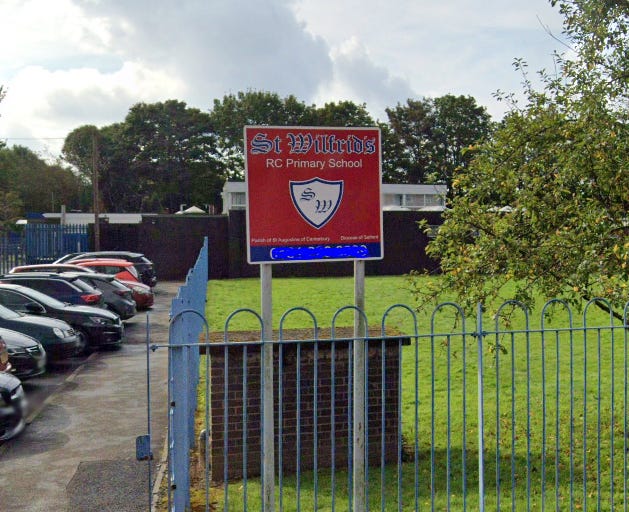The lyrics of the songs of the Smiths and Morrissey are rife with references to physical locations, most especially those within the city of Manchester. Indeed, these references encompass song titles and even album names. Anyone who has read Autobiography quickly gains an appreciation for the impact that growing up in a working class neighborhood in Manchester had upon young Morrissey.
This is the first of a multi-part series that will examine these places in detail, and includes locations not explicitly mentioned in songs that undoubtedly influenced Morrissey's lyrics, as is the case with 'The Headmaster Ritual'.
Born in 1959, Morrissey lived at 17 Harper Street in Hulme1, Manchester until 1970. According to Autobiography, he attended Primary School (which would have started when he was 4 or 5 years old) at St Wilfrid's, a Roman Catholic school located next to St Wilfrid’s Catholic Church on Birchvale Close in Hulme. While not confirmed by the author, it would seem more than likely that Morrssey was Baptized at St. Wilfrid's Church (and likely would have attended Mass there to the extent that Morrissey's family did attend church services).
Designed by architect Augustus Pugin2, St. Wilfrid's Church was built in 1842. Though now largely forgotten, Pugin was something of an architectural rock star at his height, designing the interiors of the Palace of Westminster as well as numerous churches. While appearing rather modest in comparison to other churches since built, architectural expert Clare Hartwell dubbed St Wilfrid’s ‘a seminal building in the history of 19th Century church architecture’ in her book, Manchester. Unfortunately, the former church is in a run-down state despite its Grade II listed building status.3 St Wilfrid's Primary School is still operating next to the former church, though it is housed in a new building.
Morrissey's recollections of his time at St. Wilfrid's are as bleak as a workhouse in a Dickensian novel:
"...we trudge to school ankle-deep in slush, half thawed and half-frozen [...] The school looms tall and merciless in central Hulme, as the last of the old order, a giant black shadow of ancient morality since 1842, invoking deliberate apprehension into every wide-eyed small face that cautiously holds back the tears as he or she is left at its steps - into long echoing halls of whitewashed walls, of carbolic and plimsoll and crayon blazing through the senses, demanding that all cheerful thought must now die away. This bleak mausoleum called St Wilfrid's has the power to make you unhappy, and this is the only message it is prepared to give. Padlocks and keys and endless stone stairways, down unlit hallways to darkened cloakrooms where something terrible might befall you. There are floors unused and cellars untouched in rooms unloved by ancestors who were certain that wisdom must lie in a keen self-loathing. St Wilfrid's is an asylum, of sorts, for Hulme's pitiful poor, and although it had been declared due for demolition in 1913, it grinds on, fifty years later, dragging we small children with it, plunging us into its own rooms of gloom. Children tumble in soaked by rain, and thus they remain for the rest of the day - wet shoes and wet clothes moisten the air, for this is the way. Our teachers, too, are dumped, as we are, in St Wilfrid's parish. There is no money to be had and there are no resources, just as there is no color and no laughter. These children are slackly shaped and contaminated. Many stragglers stink, and will faint due to lack of food, but there is no such thing as patient wisdom to be found in the sharp agony of the teachers."4
One can discern a connection between the lyrics of ‘The Headmaster Ritual’ and Morrissey’s stark description of students “slackly shaped and contaminated” by the absence of “patient wisdom” as well as the impact of “the sharp agony of the teachers’.
Morrissey attended St Wilfrid's Primary School up until the time that his family moved to Stretford in 1970, a move made necessary by the planned demolition of his neighborhood by the city.
In the wake of the Second World War, Hulme (which suffered significant damage from bombing during the war) was described in stark terms: “Endless rows of grimy houses: no gardens, no parks, no community buildings, no hope.”5 One can readily sense how growing up in such an environment would impact a sensitive individual such as Morrissey - so much so that it left its mark on the content of his melancholic lyrics
Keep reading with a 7-day free trial
Subscribe to Morrissey, Ringleader of The Tormentors to keep reading this post and get 7 days of free access to the full post archives.






